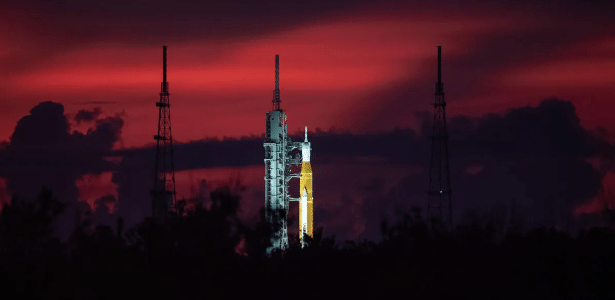Now or never. NASA’s new and most powerful rocket is ready to go to the moon. The SLS (Space Launch System) will launch tomorrow (29), at 9:33 a.m., carrying an Orion capsule. Both will go into space for the first time, in a big and risky test: a 42-day trip to our satellite and back to Earth.
This is the first mission of the ambitious Artemis program, which wants to return humans to the Moon by 2025 – and in the future, to Mars. There will be no astronauts on board this first stage, but it is very symbolic for the US space agency, fifty years after the end of the famous Apollo program – which transported 12 men to lunar soil between 1969 and 1972.
“We are approaching ‘zero hour’ for Gil Artemis,” Mission Director Mike Sarafin told reporters on Saturday. “We have high expectations.”
Many share this prediction: 200,000 people on Florida’s space coast are expected to witness history with their own eyes. The launch takes place on platform 39B of the Kennedy Space Center (KSC), and will be broadcast by NASA.
Since the end of the space shuttle program, which retired in 2011, NASA has not had its own launch system, relying on Russian technology and private companies like SpaceX to send its missions.
“We’ve been through a lot of challenges, just like every part of this rocket,” said Bruce Teller, NASA’s director of SLS engines in an interview with Space.com. “Everyone has had their own challenges that they have overcome over the years. Now I think we are ready to go as far as possible. It’s really exciting.”
Many things can go wrong
Of course, Artemis 1’s success is uncertain. “This is a very risky mission,” said Jim Frey, NASA associate administrator for exploration systems development. “There are a lot of things that can go wrong, in places where we might have to go home early, or have to abort and go back.”
In fact, the task may not launch on the specified date and time. NASA has a two-hour window to launch the SLS – so it could be as late as 11:33 a.m., in case there are any technical difficulties or weather interference, such as rain and strong winds. In the event that circumstances prevent tomorrow’s release, there are two backup dates: September 2 and 5.
“We can postpone for a number of reasons,” Sarafin said. We won’t promise that we’re leaving on Monday.”
Yesterday, during a thunderstorm, at least three lightning struck the 39B launch pad, where the SLS is located. But they were all captured by the protection system towers and weren’t powerful enough to cause damage.

